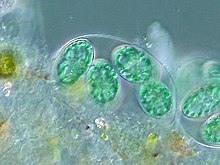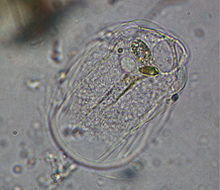Protists
The division of living beings into systematics is a continuous subject of research. Different systematic classifications exist side by side and one after the other. The taxon treated here has become obsolete due to new research or is not part of the group systematics presented in the German-language Wikipedia.
- Not to be confused with Protoctists

(light microscope image, differential interference contrast )

(secondary electron microscope image, the length of the white line corresponds to 1 micrometer)
The protists ( Greek Protista, "primordial beings", "firstlings") are a group of microscopic organisms that are not closely related , but which have long been regarded as a taxon (systematic unit). This includes all single to few cell eukaryotes , i.e. algae , protozoa and some fungi .
history
The first protists were observed by Antoni van Leeuwenhoek in 1675 . In 1866 the Protista were introduced as a taxon by Ernst Haeckel . They were conceived as a separate kingdom within the eukaryotes and contrasted with plants (Reich Plantae), animals (Reich Animalia) and mushrooms (Reich Fungi). At that time, one wanted to separate microorganisms, i.e. single and few cell organisms, from the other living beings and group them into two realms (Monera and Protista).
Although this classification lasted a long time, it does not correspond to the natural relationships. Since plants, animals and fungi evolved from protists and many multicellular organisms are related to single and few cell protists, an unnatural system arose with the protista as a paraphyletic group. In modern systematics based on relationships, the protists no longer exist. The groups belonging to the protists were assigned to different evolutionary lines according to their relationships, including two lines that contain fungi and multicellular animals or higher plants. The choanoflagellates belonging to the protists together with the mushrooms and animals form the opisthokonta . The red algae (Rhodoplantae), green algae and higher plants (Viridiplantae) form the systematic group of plants (Plantae).
Nevertheless, the term protists is still used today as a non-systematic term. A common definition is "all unicellular eukaryotes ". These include some algae , some fungi and the protozoa . However, this definition is just as difficult for cnidarians as the Myxozoa as for the Myxogastria . Today, the term protists is usually understood to mean “all one- to few-cell eukaryotes”.
Way of life
Protists often move floating by using whips or lashes or creeping, sliding, flowing or border by forming pseudopodia (pseudopodia). Quite a few species simply float in the water, floating is often supported by long cell processes.
Most protists live in the sea , partly near the surface, partly floating in the water, partly crawling on the bottom, partly stuck to stones, plants and the like; others are found in fresh water , few on land. There are heterotrophic , autotrophic , mixotrophic , aerobic and anaerobic forms. Quite a few protists also live parasitically in animals .
The protists usually reproduce by division continued asexually. With some species there are also multiple divisions, with some sexual processes occur.
meaning
Many protists appear in an astonishing number of individuals. The incorruptible remains of dead representatives - such as the silica skeletons of the radiolarians and diatoms (Bacillariophyta) or the calcareous shells of the foraminifera - are rock-forming: They sediment on the bottom of the water and through diagenesis become rocks, for example silica slate and chalk , which often form whole Assemble mountain layers.
In the course of evolution, all higher multicellular organisms emerged from primeval protists , probably mainly through the formation of cell colonies, as can still be observed today in a number of algae.
Because the cell components and the most important expressions of life, such as movement, irritability, and reproduction, can be easily studied on them, protists are a popular object of biological research. However, only about 40 species cause protozoal infections in humans and are of medical interest.
literature
- Ernst Haeckel: The Protist Empire. A popular overview of the forms of the lowest living beings. With a scientific appendix: System of the Protists. E. Günther, Leipzig 1878 ( online at biodiversitylibrary.org )
- Wilfried Westheide , Reinhard Rieger (Hrsg.): Special zoology. Part 1: Protozoa and invertebrates. 2nd Edition. Spektrum Akademischer Verlag, Heidelberg 2006, ISBN 3-8274-1575-6 .
- Robert H. Whittaker: New Concepts of Kingdoms. In: Science . Vol. 163, 1969, pp. 150-160.
Individual evidence
- ^ Erwin J. Hentschel, Günther H. Wagner : Zoological dictionary . 6th edition. Gustav Fischer Verlag Jena, Jena 1996, p. 497 .
- ↑ Antony van Leewenhoeck: Observations, Communicated to the publisher by Mr. Antony van Leewenhoeck in a Dutch Letter of the 9th of Octob. 1676. Here English'd: Concerning little animals by him observed in Rain, Well, Sea and Snow Water; as also in water wherein Pepper had lain infused. In: Philosophical Transactions of the Royal Society of London Vol. 11, No. 133, 1677, pp. 821-831. doi: 10.1098 / rstl.1677.0003 ( full text ).
- ↑ Saunders, GW, Hommersand, M. (2004): Assessing red algal supraordinal diversity and taxonomy in the context of contemporary systematic data. American Journal of Botany 91 : 1494-1507.


